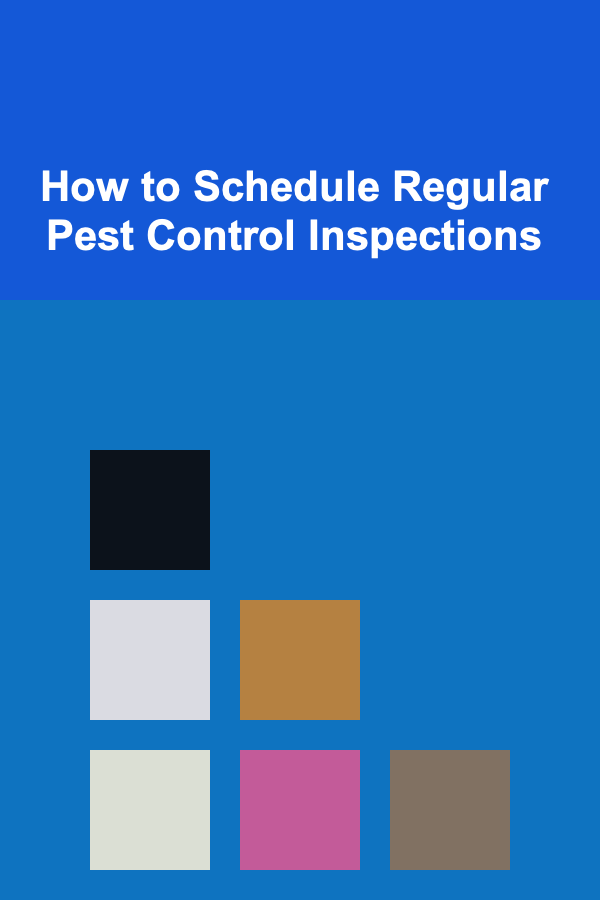
How to Schedule Regular Pest Control Inspections
ebook include PDF & Audio bundle (Micro Guide)
$12.99$5.99
Limited Time Offer! Order within the next:

Pest control is a critical aspect of maintaining a healthy living environment. Whether you own a home, manage a rental property, or oversee a commercial space, regular pest control inspections can help identify potential infestations before they escalate into significant problems. This article serves as a comprehensive guide on how to schedule regular pest control inspections, addressing the importance of pest management, factors to consider in scheduling, and practical steps for implementation.
Understanding the Importance of Regular Pest Control Inspections
1.1 Health Risks Associated with Pests
Pests can pose significant health risks to individuals and families. Common pests such as rodents, cockroaches, and ants can carry diseases that affect humans:
- Rodents: Can transmit diseases like Hantavirus and Leptospirosis through droppings and urine.
- Cockroaches: Known to trigger asthma and allergies; their droppings and body parts can contaminate food.
- Ants: Some species bite or sting, while others can contaminate food supplies with bacteria.
Regular pest control inspections help mitigate these health risks by identifying and managing pest populations before they become a problem.
1.2 Economic Impact of Pest Infestations
Pest infestations can lead to significant economic costs, including:
- Property Damage: Termites, carpenter ants, and other wood-destroying insects can compromise structural integrity, leading to costly repairs.
- Loss of Inventory: For businesses, pests can spoil perishable goods or damage products, resulting in financial losses.
- Increased Utility Costs: Pest infestations may increase energy costs due to compromised insulation or airflow.
Regular inspections enable early detection, thus minimizing potential economic impacts.
1.3 Preserving Property Value
Maintaining a pest-free property is essential for preserving its value. A well-kept environment not only enhances the aesthetic appeal but also protects against depreciation caused by infestations. Homebuyers are likely to be deterred by properties with a history of pest issues, making it imperative to keep up with regular inspections.
1.4 Peace of Mind
Knowing that your home or business is regularly inspected for pests provides peace of mind. It eliminates worries about potential infestations and allows occupants to focus on their daily activities without the stress of hidden pest problems.
Identifying Types of Pests
Understanding the types of pests common to your area is crucial when planning for pest control inspections.
2.1 Common Household Pests
Households often face various pests, including:
- Termites: Wood-destroying insects that can cause significant structural damage.
- Bed Bugs: Small, nocturnal insects that feed on human blood, causing itchy bites.
- Cockroaches: Resilient pests that breed quickly and can carry diseases.
- Ants: Various species, some of which can contaminate food or bite.
2.2 Commercial Property Pests
For businesses, specific pests might be more prevalent, depending on the industry:
- Rodents: Common in food processing and storage facilities.
- Flies: Particularly problematic in restaurants and kitchens.
- Stored Product Pests: Insects like weevils that infest grains and food products.
Understanding these pests helps tailor the inspection schedule and ensure better prevention strategies.
Assessing Your Pest Control Needs
Before scheduling regular inspections, it's essential to assess your specific needs based on various factors.
3.1 Frequency of Inspections
The frequency of pest control inspections depends on several factors:
- Property Type: Residential properties typically require fewer inspections than commercial ones.
- Location: Properties in rural areas or near water sources may face higher pest pressures.
- History of Infestations: If your property has had previous issues, more frequent inspections may be warranted.
3.2 Severity of Past Infestations
Evaluate any past pest problems. A severe infestation may necessitate more frequent inspections and proactive measures compared to properties with no history of pest issues.
3.3 Seasonal Considerations
Certain pests are more prevalent during particular seasons. For example:
- Spring and Summer: Increased activity from ants, wasps, and mosquitoes.
- Fall: Rodent invasions as animals seek shelter for winter.
Scheduling inspections at key times can be beneficial in preventing infestations.
Choosing a Pest Control Service
Selecting the right pest control service is vital for effective management and prevention.
4.1 Researching Providers
Begin your search by researching local pest control companies. Look for providers with a solid reputation, extensive experience, and specialized services suitable for your needs.
4.2 Evaluating Services Offered
Not all pest control companies offer the same services. Evaluate their range of offerings, including:
- Inspection Services: Comprehensive evaluations of your property for signs of pests.
- Treatment Options: Chemical and non-chemical treatments, integrated pest management techniques.
- Follow-up Services: Ongoing monitoring and periodic inspections.
4.3 Checking Credentials and Reviews
Verify credentials and licenses before committing to a pest control provider. Check online reviews and testimonials to gauge customer satisfaction and the effectiveness of their services. Don't hesitate to ask for references.
Establishing a Regular Inspection Schedule
Once you have chosen a pest control provider, the next step is to establish a practical inspection schedule.
5.1 Creating a Calendar
Set up a calendar specifically for pest control inspections. You can choose between a physical calendar, a digital version, or specialized apps that allow better tracking.
- Include Initial Inspection Dates: Mark the date of the first inspection after hiring the service.
- Schedule Recurring Inspections: Based on the previously discussed frequency, block out dates for future inspections.
5.2 Setting Reminders
Utilize reminder systems to ensure you don't forget upcoming inspections. Whether through phone alerts, email notifications, or calendar reminders, timely alerts will help you stay on track.
5.3 Incorporating Inspections into Routine Maintenance
Consider integrating pest control inspections into your overall home or property maintenance schedule. Align them with other seasonal activities, such as HVAC servicing or landscaping, for comprehensive upkeep.
Preparing for Inspections
Preparation is key to successful pest control inspections. By taking the time to prepare properly, you can facilitate a more thorough evaluation and effective treatment if necessary.
6.1 Conducting Pre-Inspection Assessments
Before the pest control technician arrives, conduct a preliminary assessment of your property. Look for visible signs of pests such as:
- Droppings
- Gnaw marks
- Nesting materials
- Signs of damage
This information can provide valuable insights for the inspector.
6.2 Clearing Areas for Access
Ensure that areas requiring inspection are accessible. Move furniture, appliances, and clutter away from potential pest hiding spots such as:
- Corners and edges
- Attics and basements
- Behind large appliances
This will allow the technician to perform a thorough check without obstructions.
6.3 Communicating with the Pest Control Technician
Be prepared to discuss any concerns or observations with the pest control technician. Share details about:
- Any recent sightings of pests
- Changes in property usage (e.g., new construction or renovations)
- Seasonal changes affecting pest activity
Open communication will help the technician tailor their approach to your specific situation.
Post-Inspection Follow-Up
After the pest control inspection, there are several important follow-up steps to take.
7.1 Understanding the Findings
Carefully review the inspection report provided by the technician. Ensure you understand their findings, including any identified pest issues, potential entry points, and recommendations for treatment.
7.2 Taking Action on Recommendations
If the inspection reveals issues that need addressing, take prompt action:
- Schedule Treatments: Arrange for the recommended pest control treatments as soon as possible.
- Implement Preventative Measures: Follow suggested preventative measures, such as sealing entry points or changing cleaning habits.
7.3 Documenting Pest Control Activities
Maintain detailed records of all pest control inspections, treatments, and follow-ups. This documentation should include:
- Dates of inspections and treatments
- Specific findings and recommendations
- Actions taken in response to the findings
Keeping detailed records helps track trends over time and informs future pest management decisions.
Conclusion
Scheduling regular pest control inspections is an essential component of maintaining a safe and healthy environment, whether for your home or business. By understanding the significance of pest management, recognizing the types of pests that may infest your property, and establishing a systematic approach to inspections, you can proactively prevent pest-related issues.
From assessing your specific needs to selecting a reliable pest control service and preparing for inspections, each step plays a critical role in effective pest management. Implementing these strategies will not only save you time and money but also contribute to the long-term safety and comfort of your living or working space.
By prioritizing regular inspections and staying vigilant about pest control, you can enjoy peace of mind and protect your property from the myriad of challenges posed by pests.

How to Build a Checklist for Content Inventory Before Website Migration
Read More
How to Choose Flooring That Fits Your Style and Budget
Read More
How to Designate Zones for Different Types of Workouts
Read More
How to Organize a Small Dining Area for Functionality
Read More
How to Use a Calendar to Stay Organized at Home
Read More
Innovative Strategies: A Practical Approach to Patent Prosecution
Read MoreOther Products

How to Build a Checklist for Content Inventory Before Website Migration
Read More
How to Choose Flooring That Fits Your Style and Budget
Read More
How to Designate Zones for Different Types of Workouts
Read More
How to Organize a Small Dining Area for Functionality
Read More
How to Use a Calendar to Stay Organized at Home
Read More